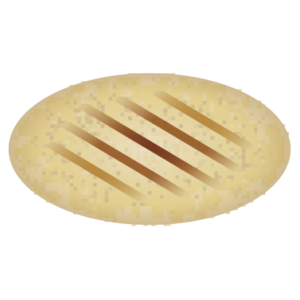
Today, emojis help us share our deepest emotions, like ❤️, 😂, 😤, or more urgent thoughts like “🍣 or 🍔 tonight?” Emojis offer a way to add emotional subtext to a digital message that might otherwise feel 😔.
But where do emojis come from? Who makes them? Who decides which emojis are offered as options?
And how are emojis evolving to reflect the diversity of our global community? [The answer is: because of a group of passionate and dedicated people—and maybe even you!]
In 1999, artist Shigetaka Kurita and his colleagues at Japanese telecom NTT DOCOMO, INC. developed one of the earliest emojis for mobile phones and pagers. The word emoji comes from the Japanese 絵 (“e,” picture), 文 (“mo,” write) and 字 (“ji,” character). The picture characters caught on quickly and spurred on the global trend of text messaging with emojis to communicate.

Graphic artist Shigetaka Kurita drew on manga and preexisting dingbats and glyphs to create the original 176 emoji for NTT DOCOMO mobile devices. Kurita worked within a 12 x 12 grid, dictated by the character constraints of the early “i-mode” mobile internet system. Many of today’s Unicode characters based on emojis can be traced back to Kurita’s original set. As for Kurita’s favorite? “The heart is my number-one favorite emoji, because among the various emoji, [its meaning] is very positive.” (See an early Japanese i-mode mobile phone in the museum’s mobile gallery in the Revolution exhibit here.) Emoji set credit: © NTT DOCOMO, INC.

A subset of the current 1,800 and growing Emoji List, v. 15.0. Credit: unicode.org
NTT DOCOMO’s emojis are one of the earliest large sets of emojis. Previous sets existed in standalone programs, such as Microsoft’s Wingdings (a font invented in 1990) or the University of Illinois’ online learning system, PLATO, in the 1970s. Since 2010, the nonprofit Unicode Consortium ensures characters display in all languages, and its emoji subcommittee approves new emojis (a process open to anyone).
Creating new emojis to promote a more inclusive world has become a mission for a diverse group of passionate people. Would you like to join them? What would YOUR emoji be?


Yiying Lu, an artist and designer, discovered there was no emoji to represent her favorite food—a dumpling. She submitted her design to Unicode in January 2016. The dumpling emoji was approved as part of Unicode 10.0 in 2017 and added to Emoji 5.0 in 2017. Since then, Yiying created artworks and championed five more emojis, including chopsticks, a Chinese takeout box, fortune cookie, boba tea and peacock. Lu is cofounder of Emojination, an organization that designs and advocates for more inclusive emojis. She created the Computer History Museum’s “Little Emoji, Big Story” graphics!”

Yiying Lu (upper right) explains that originally her boba tea emoji was rejected by Unicode due to insufficient data showing its popularity. In 2018, she worked with data scientists Timothy Deng (upper left), Sujay Khandekar (lower left) and Ranjitha Kumar (lower right), who used Google Analytics to prove boba tea’s global popularity. The boba tea emoji was approved by Unicode in 2020.
🥡 Emoji Fun Fact: The Chinese take-out box isn’t from China or anywhere else in Asia. It’s an American invention by Frederick Weeks Wilcox, who patented a version in 1894 to hold oysters. In the 1970s, the company Fold-Pak put a pagoda on the side of it and the rest is history. Ironically, it’s used in many countries for take-out food but rarely seen in China or other Asian countries. Emojis, like all symbols, can have a multilayered history.


Paul Hunt, a typeface designer at Adobe, is a champion for gender-neutral or nonbinary emojis. He recognized that making users choose between caricatures of masculinity and femininity was not very inclusive, so he created a proposal for a gender-neutral option for each human emoji. As a result, the Unicode emoji subcommittee added the first gender-inclusive emojis: a child, an adult and an elder, all designed by Hunt to be completely nongendered.


Katrina Parrott, an aerospace industry executive, was inspired by a conversation with her teenage daughter, Katy, in 2013. Together, they noticed that there was a serious lack of racial representation in emoji choices. To tackle the problem, Parrott assembled a small team and designed over 900 diverse emojis, eventually leading Unicode to adopt five skin tones.


Rayouf Alhumedhi proposed the idea to include a woman in a hijab to Unicode in 2016 when she was 15 years old. When texting with her friends on WhatsApp, she realized that there was no emoji that looked like her or any of millions of other hijab-wearing Muslim women across the world. She hastily drafted a proposal to Unicode, then worked with the organization to design the emoji and get it approved


Lumen Bigott, a graphic designer, worked with fellow-Venezuelan Sebastian Delmont, a software developer, to create the first flatbread emoji, a staple food in Central and South America made of ground corn, called “arepa.” The arepa emoji was approved by Unicode in 2020.


Jennifer 8. Lee is a journalist and film producer and has been a self-described emoji activist since 2016. She cofounded emojination.org, a grassroots group with the motto “Emoji for the People, By The People,” that advocates for more inclusive and representative emoji. In 2021, she coproduced the documentary The Emoji Story that tells the story of the evolution of the emoji, from its humble beginning to today’s efforts to make the emoji language more representative of its billions of users.